Paleoanthropology is the study of ancient humans and some of the creatures most similar to them. The term comes from a combination of several Greek words. Palai means long ago or ancient, while Anthropos refers to mankind. This field has expanded beyond studying humans to include fossil hominids. Hominids are a diverse group of creatures ranging from humans to chimpanzees. All of these are classified within the family Hominidae. Young-earth creationists do not think that all the hominids are related to one another, although they do share many features in common. Broadly, we can divide hominids into two groups: non-humans and humans.
Non-Human Fossils
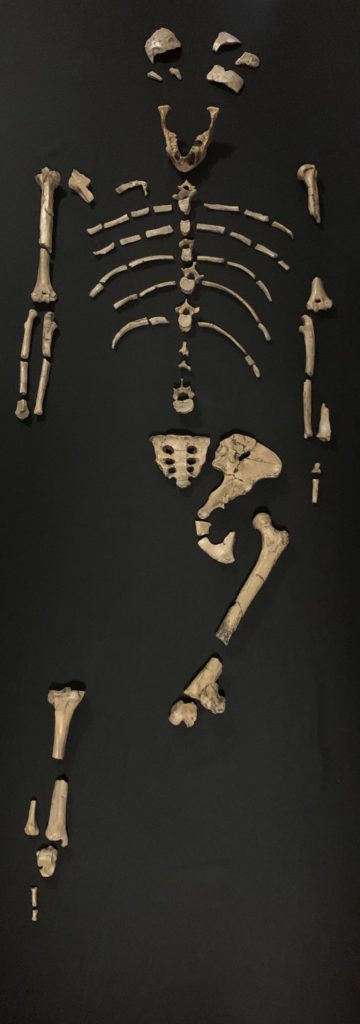
The earliest hominin species from which we have a fairly complete skeleton is Ardipithecus ramidus. Known as “Ardi” the skeleton comes from the Middle Awash Region of Ethiopia. Many of her bones are crushed and fragmentary, but scientists are fairly certain that at least some of the time Ardi was bipedal. Standing upright, she would have been about four feet tall. The bones of her hand and arm reveal that Ardi was also at home in the trees. While Ardi was unique from the extant apes alive today, Ardipithecus was not human. Radiometric dating places this fossil around 4.4 million years old. Although we believe radiometric dating heavily inflates the age of tested objects, it is likely that this method works in a relative sense, allowing us to compare the ages of various fossils.
Another famous hominin skeleton nicknamed “Lucy” was discovered in the Afar region of Ethiopia. This skeleton belonged to the species Australopithecus afarensis. Lucy’s skeleton reveals that she was a habitual biped,1 with a height of around three feet. She did not have some of the important features for tree-climbing seen in Ardi and the extant apes. Lucy’s bones come from rock layers which have been radiometrically dated at around 3.2 million years old. In the relative sense, young earth creationists learn from this that “Lucy” is a younger or more recent fossil than “Ardi”.
Human Fossils
The earliest human bones yet discovered come from Africa. One example is a jawbone from the country of Malawi which is radiometrically dated to be 2.4 million years old. On a young earth time scale, this bone is younger than both “Lucy” and “Ardi”. Although this mandible is human, it differs from ours in a number of ways. This suggests that the original humans may have looked somewhat different from us. After this first appearance in the fossil record, evidence of humans shows up far across the globe in Shangchen, China, where scientists have found a collection of stone tools radiometrically dated to be about 2.1 million years old.2

The Nariokotome Boy is a nicely preserved skeleton from Turkana, Kenya. This fossil is the remains of a juvenile Homo erectus individual who was a little over five feet tall. Homo erectus was human, but had a smaller brain on average, a bony ridge above the eyes, and other unique features not seen in modern people. We have good evidence that Homo erectus used fire and made a variety of stone tools. The Nariokotome Boy is radiometrically dated to be around 1.5 million years old.
The Timeline
The order of the hominin fossil record is very important for understanding how hominins have changed through time. The fossil record of the australopithecines begins to fade out about the time when the first human fossils appear. Conventional scientists believe that this is in part due to the first humans outcompeting their ancestors. A creationist perspective would interpret this differently. After the Flood, the ark landed on the mountains of Ararat, and from there animals dispersed over the earth. Humans, on the other hand, seem to have settled near Ararat, before traveling to the land of Shinar. This means that we should expect non-human fossils to appear first after the Flood.
What Can We Learn by Studying Hominin Fossils?
Careful study of hominid bones can reveal quite a lot about the creatures to whom they belonged. Examining the shape and size of teeth can tell us what sorts of food a creature was eating. Sometimes the shape of the brain can be preserved, which might tell us about the ability for speech and thought. Comparing fossil limb bones to those of living creatures gives us an idea of how these ancient hominids moved. When we are able to extract DNA from fossils, it can tell us quite a bit about how we are related to other ancient humans.
A Young Earth Creationist Interpretation
Young Earth Creationists believe that humans are unrelated to God’s other creatures. This view stems from a literal interpretation of Genesis 1 and 2. In both of these chapters, the text emphasizes the unique and separate creation of humans. God formed Adam out of the dust, rather than calling him into existence instantaneously, as He did with the other land-dwelling creatures. Unlike God’s other creations, Adam had a soul, was given God’s Image, and had dominion over creation.
Conventional scientists think that chimpanzees are the closest living relatives to humans, rather like a long lost cousin. They believe that around six million years ago, an ancestral population of apes split into two groups. One of these groups would evolve into modern chimpanzees, while the other would evolve into humans. Their view is best characterized as a gradient, beginning with this ancestral ape population and ending with humans. They argue that there must have been a smooth transition of form, such that if we were to see the population during this time, we would not be able to tell when the first humans appeared, because the change happened so slowly and at such a minute level.
Statistical studies of hominin fossils show that humans are discontinuous with their supposed ancestors. There is a morphological gap between us and the Australopithecines. The fossil record does not support the idea that this physical gap was crossed in the distant past. This supports the conclusion that humans are unrelated to other creatures, and form their own created kind.
Complexity of Ancient Humans
For those who do not believe humans were created, the origin of abstract and rational thought remains a challenge to explain. The Bible teaches that our mental capacity is a result of being endowed with the Image of God and is partially non-physical. Humans are the only creatures known to make fire, perform ritual burial, and speak intelligently. The fossil record shows that ancient humans like the Neanderthals were no less human than us. They made complex tools, buried their dead and made art.
What Happened to People Who Died in the Flood?
All of the human fossils which we know of come from post-Flood rock layers. This provides an interesting challenge to young-earth creationism, as we would expect to find remains or artifacts of humans buried in the Flood. There are several possible answers to this problem. Some young-earth creationists argue that pre-Flood populations of humans may not have been very large, and thus their fossils would be rare.
What Happened to Humans After the Flood?
Following the Flood, humans diversified into a number of forms.3 Some humans adapted to life on islands by becoming smaller. Others, like the Neanderthals adapted to cold northern climates. Eventually our own species, Homo sapiens, became the most widespread human form, perhaps before the time of Abraham.
Conclusion
Paleoanthropology is an exciting field of science, because there is still so much to discover about ancient hominins. As young-earth creationists we have a lot of work to do, developing and expanding our models of how humans spread following the Flood. Ultimately, what we are sure of is that humans are a unique creation of God, made to glorify Him for His works.
Footnotes
- Murdock, Matthew. 2006. “These apes were made for walking: the pelves of Australopithecus afarensis and australopithecus africanus.” Journal of Creation 20 (2). ↩︎
- Barras, Collin. 2018. “Tools from China are oldest hint of human lineage outside Africa.” Nature News July 11. ↩︎
- Wise, Kurt. 2005. “The Flores Skeleton and Human Baraminology.” Occas. Papers of the BSG No. 6, pp. 1-13. ↩︎

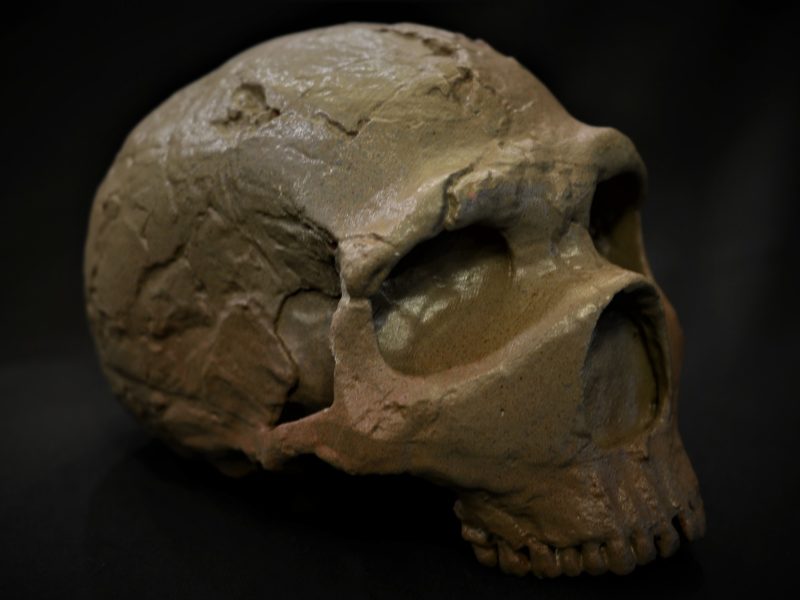
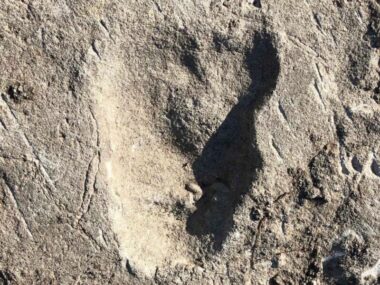
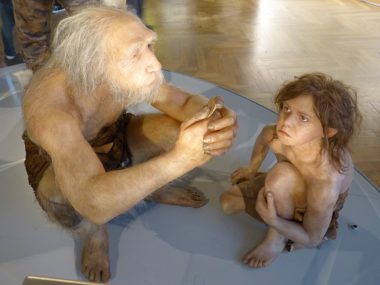
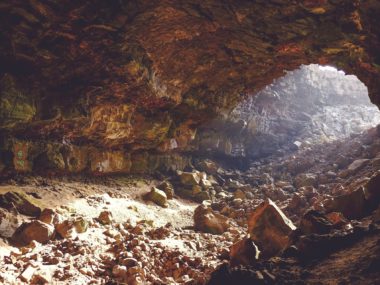
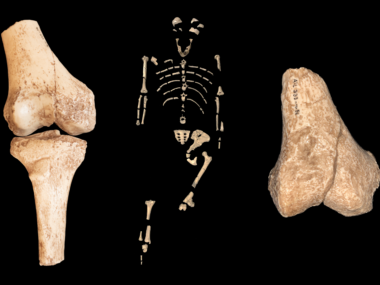

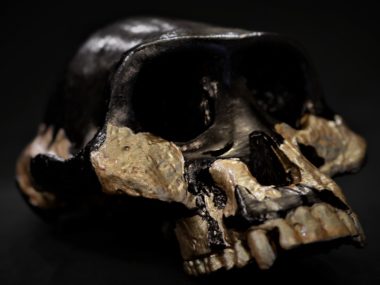




I came across an article and then the technical paper behind it regarding early Homo fossils. I attached both for reference. They really focus on the Dmanisi fossils but the findings indicated that early Homo, including even erectus and ergaster specimens earlier than 1.7 MYA (the specific list of fossils are listed in the paper but has several erectus and ergaster fossils besides Dmanisi listed) had ape-like brains and not human brains.
To me this seems disturbing to the young earth creation model that has erectus and ergaster as fully human. This is the first evidence I’ve seen of an ape-like brain for early Homo fossils that seems to evolve into a human brain later.
I think this is worth addressing in creation science as it seems like a game changer.
I believe in Jesus and young earth creationism but I admit this really shook me.
Is it possible to address this? I definitely think it’s worth mentioning.
https://scitechdaily.com/earliest-homo-populations-in-africa-had-primitive-ape-like-brains-just-half-the-size-of-todays-humans/amp/
https://www.researchgate.net/publication/350777083_The_primitive_brain_of_early_Homo
The whole problem with the idea of evolution is that requires the model of death. It requires generations that die in the process of “making it to human”. The Bible states that death entered with sin. We don’t have to be able to answer all the questions that might come to mind like what would have happened if nothing died. Even now, in its sinful state, mankind is thinking of going to Mars. Enoch was translated. Who know what would have happened if there had never been sin and death? But sin and death entered the world and required the Saviour, Jesus, to remedy that. If death came some other way than entering with sin, then why the cross? Evolution negates the gospel message. Go back to the purpose of the cross. Go back to where death entered. It cuts through the confusion.
I’m not an expert on this topic, but I do know that much of what experts “know” about the fossil record is based on assumptions. We weren’t there to observe the events that resulted in the fossil record, so certain things are assumed that even the community of experts disagree on. Your question appears to me to be about something that fits in that category. The assumption is made that the fossils referenced are human. Do we know for a fact that they are not an extinct species of ape? Again, I’m far from an expert and may be oversimplifying the issue, but is it possible that this is the case? If the fossil record contradicts what God has told us in His word, guess which is wrong? No community of “experts” can overrule God.
In regards to the Nariokotome Boy, it is almost certain that he was a human. Homo erectus fossils have been associated with stone tools and fire. In addition, we have evidence that they would have been able to speak like we do. I don’t think that Homo erectus being human really contradicts the scripture or causes problem for creationists. These people were simply one of many post Babel groups who had some unique features.
Actually, upon further review of the actual technical paper that made the claim, I only found one brain that look decidedly ape-like and that was Dmanisi Skull 5.
All the others, especially Dmanisi Skulls 1 and 4 as well as KNM ER 1813, KNM ER 3733, and WT 15000 Turkana Boy as well as the other erectus skulls all looked decidedly like they had human brains.
Besides the overall shape, there are two distinctive ways to tell an ape brain from a human brain: first, whether or not there is a lunate sulcus in the back of the brain (typically only seen in apes), and second whether the front lobe of the brain shows either a Broca’s area (humans) vs a fronto orbital sulcus (apes).
Dmanisi Skull 5 showed a lanute sulcus and a fronto orbital sulcus as well as an overall brain shape suggesting an ape like brain. Most likely that would make it an Australopithecine.
Dmanisi Skulls 1 and 4 as well as KNM ER 1813, KNM ER 3733, and WT 15000 Turkana Boy as well as the other erectus skulls did not show a lanute sulcus and all showed a human like Broca’s area as human like brain shape including the frontal lobes. Similar to Homo naledi, which had a human like brain and was likely human.
Based on Skull 5’s shape and other characteristics of it I wasn’t surprised to see the ape like brain there. Based on all the other skulls I named I was not surprised to see they looked human.
Overall, all the Homo erectus specimens and Dmanisi Skulls 1-4 are human.
This all actually backs up Biblical young earth creation very well.
Praise be to Jesus.
God Bless.
You ask what might have happened to people who died in the flood.
I have thought that as we share DNA with Neanderthals, could it be that the Neanderthals are the preflood men?
Noah and his family will then only have a small proportion of their DNA the same as the Neanderthals.
Creation scientists think that Neanderthals lived after the Flood because of the rock layers in which they are found. Many creation geologists think that the boundary between layers formed in the Flood, and those formed afterwards is the Cretaceous-Tertiary boundary. Neanderthal fossils come from rock layers deposited after this boundary. This means that they probably lived after the flood.